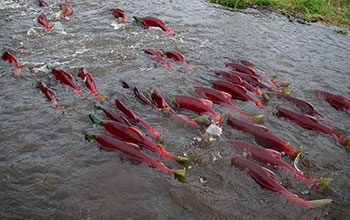Multimedia Gallery
Magnetism may help salmon find home (Image 2)
When sockeye salmon migrate from salt water to fresh water, they change colors, going from their ocean colors of mostly silver with some darker coloration on their backs (like a lot of other ocean fish) to red when in fresh water. [See related image Here.]
More about this image
When migrating, sockeye salmon typically swim up to 4,000 miles into the ocean and then, years later, navigate back to the upstream reaches of the rivers in which they were born to spawn their young. Scientists, the fishing community and lay people have long wondered how salmon find their way to their home rivers over such epic distances. But a study funded in part by the National Science Foundation (NSF) suggests that salmon find their home rivers by sensing the rivers' unique magnetic signature.
Nathan Putman, a postdoctoral researcher at Oregon State University and the lead author of the study, and a research team used data from more than 56 years of catches in salmon fisheries to identify the routes that salmon had taken from their most northerly destinations, which were probably near Alaska or the Aleutian Islands in the Pacific Ocean, to the mouth of their home river -- the Fraser River in British Columbia, Canada. This data was compared to the intensity of the Earth's magnetic field at pivotal locations in the salmon's migratory route.
Results of the study showed that the intensity of the magnetic field largely predicted which route the salmon used to detour around Vancouver Island. In any given year, the salmon were more likely to take whichever route had a magnetic signature that most closely matched that of the Fraser River years before, when the salmon initially swam from the river into the Pacific Ocean.
"These results are consistent with the idea that juvenile salmon imprint on (i.e. learn and remember) the magnetic signature of their home river, and then seek that same magnetic signature during their spawning migration," said Putman.
Learn more in this NSF News Release: Animal magnetism: first evidence that magnetism helps salmon find home. (Date image taken: 2007; date originally posted to NSF Multimedia Gallery: Oct. 19, 2017)
Credit: Dr. Tom Quinn, University of Washington
See other images like this on your iPhone or iPad download NSF Science Zone on the Apple App Store.
Images and other media in the National Science Foundation Multimedia Gallery are available for use in print and electronic material by NSF employees, members of the media, university staff, teachers and the general public. All media in the gallery are intended for personal, educational and nonprofit/non-commercial use only.
Images credited to the National Science Foundation, a federal agency, are in the public domain. The images were created by employees of the United States Government as part of their official duties or prepared by contractors as "works for hire" for NSF. You may freely use NSF-credited images and, at your discretion, credit NSF with a "Courtesy: National Science Foundation" notation.
Additional information about general usage can be found in Conditions.
Also Available:
Download the high-resolution JPG version of the image. (2.9 MB)
Use your mouse to right-click (Mac users may need to Ctrl-click) the link above and choose the option that will save the file or target to your computer.

